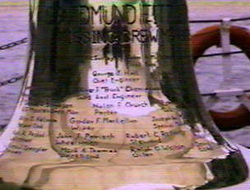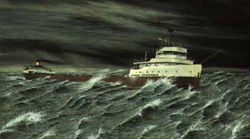The Wreck of the Edmund Fitzgerald
Late on the afternoon of the 10th, the captain of the Fitzgerald made radio contact with another ship, the Avafor, and reported that they "had a bad list, had lost both radars, and was taking heavy seas over the deck in one of the worst seas he had ever been in." Captain McSorely was a seasoned sailor of the Great Lakes with 44 years of experience. The storm that hit when the Fitzgerald went down was one of the biggest, and the worst that Captain McSorley said he had ever seen. In the Fitzgerald's storm, winds as fast as 45 knots were reported, with waves as high as thirty feet. Both water pumps on the Edmund Fitzgerald were damaged, and the lifeboats were destroyed by the force of the storm.
At 7 p.m. the Anderson made radio contact with the Fitzgerald and had her on their radar. When asked how the Fitzgerald was making out they replied "We are holding our own". This was around 7:10 p.m.. Shortly afterwards the Fitzgerald disappeared from the Anderson's radar screen.
"...At seven p.m. a main hatchway caved in he said 'fellas it's bin good to know ya' The captain wired in he had water comin' in and the good ship and crew was in peril and later that night when 'is lights went out of sight came the wreck of the Edmund Fitzgerald"
At 7 p.m. the Anderson made radio contact with the Fitzgerald and had her on their radar. When asked how the Fitzgerald was making out they replied "We are holding our own". This was around 7:10 p.m.. Shortly afterwards the Fitzgerald disappeared from the Anderson's radar screen.
"...At seven p.m. a main hatchway caved in he said 'fellas it's bin good to know ya' The captain wired in he had water comin' in and the good ship and crew was in peril and later that night when 'is lights went out of sight came the wreck of the Edmund Fitzgerald"
The Edmund Fitzgerald was lost with her entire crew of 29 men on Lake Superior November 10, 1975, 17 miles north-northwest of Whitefish Point, Michigan.

Brave men who were lost that night: Captain Ernest M. McSorley Michael E. Armagost Fred J. Beetcher Thomas D. Bentsen Edward F. Bindon Thomas D. Borgeson Oliver J. Champeau Nolan S. Church Ransom E. Cundy Thomas E. Edwards Russell G. Haskell George J. Holl Bruce L. Hudson Allen G. Kalmon Gorden Maclellan Joseph Mazes John H. McCarthy Eugene O'Brien Karl A. Peckol John J. Poviach James A. Pratt Robert C. Rafferty Paul M. Rippa John D. Simmons William J. Spengler Mark A. Thomas Ralph G. Walton David E. Wiess Blaine H. Wilhelm
The ship's bell, which was attached to the roof of the pilothouse, was unanimously selected to serve this important purpose. Further, it was suggested that a replica bell, inscribed with the names of the lost crewmen, be placed on the wreck as a permanent grave marker.
The bell was transported aboard HMCS Cormorant to Sault Ste. Marie, Ontario, where it was respectfully displayed to the public. On Friday, July 7, the bell was formally presented to the family members by Diane Cunningham, Ontario Minister of Inter-Governmental Affairs. In a ceremony titled "Call to the Last Watch" the bell was then tolled 30 times, 29 for each man who lost his life on the Fitzgerald, with the final toll for all sailors who have died on the Great Lakes
The ship's bell, which was attached to the roof of the pilothouse, was unanimously selected to serve this important purpose. Further, it was suggested that a replica bell, inscribed with the names of the lost crewmen, be placed on the wreck as a permanent grave marker.
The bell was transported aboard HMCS Cormorant to Sault Ste. Marie, Ontario, where it was respectfully displayed to the public. On Friday, July 7, the bell was formally presented to the family members by Diane Cunningham, Ontario Minister of Inter-Governmental Affairs. In a ceremony titled "Call to the Last Watch" the bell was then tolled 30 times, 29 for each man who lost his life on the Fitzgerald, with the final toll for all sailors who have died on the Great Lakes




